Quarterly Banking Profile - First Quarter 2019
Good morning, and welcome to our release of first quarter 2019 performance results for FDIC-insured institutions.
This was another positive quarter for the banking industry. Quarterly net income improved from a year ago, led by higher net interest income. Net interest margins widened, asset quality indicators remained stable, and the number of "problem banks" remains low.
Community banks also reported another positive quarter. Net income at community banks benefited from higher net interest income and lower provision expenses, and the annual rate of loan growth at community banks was stronger than the overall industry.
In July, this economic expansion will be the longest on record in the United States. As a result, the nation's banks are strong.
With the recent stabilization of interest rates, new challenges for banks in lending and funding may emerge. The competition to attract deposit and loan customers is strong, and therefore, banks need to maintain rigorous underwriting standards and prudent risk management.
These factors have increased banks' exposure to interest rate, liquidity, and credit risk. Attention to these risks will position banks to be more resilient in sustaining lending through the downside of an economic cycle.
I am joined here today by Diane Ellis, Director of the Division of Insurance and Research; Pat Mitchell, Deputy Director of the Division of Insurance and Research; and Doreen Eberley, Director of the Division of Risk Management Supervision, to help provide details about bank performance during the first quarter.
Diane, I will turn this over to you. Thank you.
Chart 1:
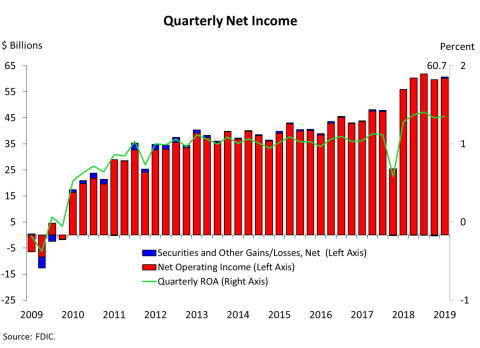
Thank you, Chairman McWilliams.
Our first chart shows that the banking industry reported quarterly net income of 60.7 billion dollars during the first quarter, an increase of 8.7 percent from a year ago. Almost two-thirds of all banks reported annual increases in net income and less than 4 percent of institutions were unprofitable. The industry's return-on-assets ratio rose to 1.35 percent in the first quarter, up from 1.28 percent a year earlier.
Community banks reported quarterly net income of 6.5 billion dollars in the first quarter, an increase of 10.1 percent from a year ago.
Chart 2:
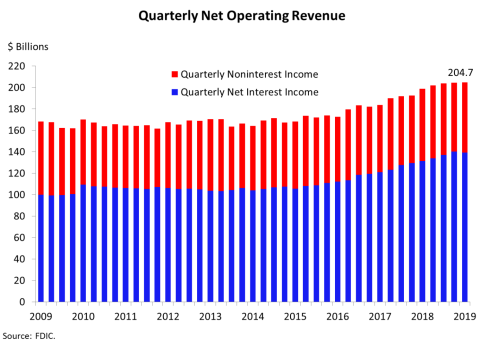
The next chart shows that net operating revenue totaled 204.7 billion dollars in the first quarter, an increase of 3 percent from a year earlier. The growth in revenue was led by higher net interest income, which grew by 6 percent, as a result of loan growth and higher margins.
Noninterest income declined by 2.9 percent from a year ago, due to lower servicing fees, income from fiduciary activities, and other noninterest income. More than half – 53 percent – of all banks reported lower noninterest income from 12 months ago.
Chart 3:
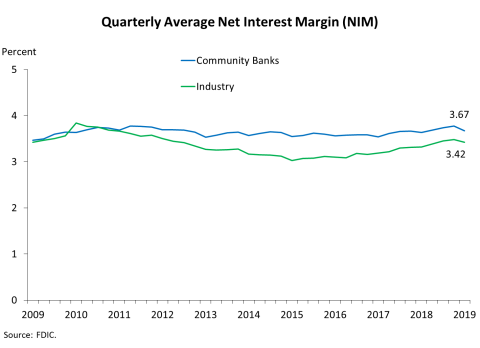
Chart 3 shows that the average net interest margin for the industry was 3.42 percent in the first quarter, up from 3.32 percent a year ago. The average funding cost rose by 39 basis points from first quarter 2018, while the average asset yield increased by 49 basis points.
Community banks continue to report a higher average net interest margin compared to the overall banking industry. However, the gap has been narrowing. Large institutions have benefitted more than community banks from rising short-term interest rates, as large institutions have a greater share of assets that reprice quickly.
Chart 4:
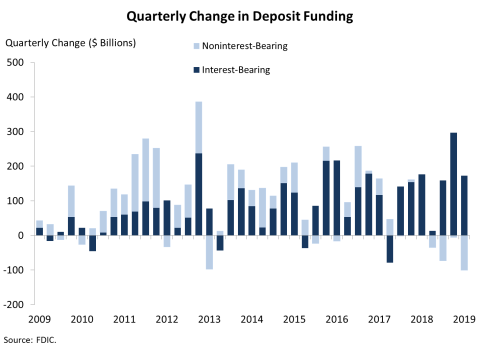
Chart 4 shows a recent shift from noninterest-bearing deposits to interest-bearing deposits. The competition to retain deposits at higher interest rates could result in net interest margin pressure for banks, especially at banks with significant exposure to longer-term assets or those that rely on rate-sensitive deposits.
With the recent stabilization of interest rates, the industry could face additional headwinds against future earnings as liabilities may reprice greater than assets.
The share of longer-term assets relative to total industry assets remains elevated, with more than one-third of industry assets maturing or repricing in three or more years.
Some banks have responded to low interest rates by "reaching for yield" through investing in longer-term assets or reducing liquid assets to increase their yield on earning assets and maintain net interest margins.
So far, most banks have benefited from rising interest rates largely from assets repricing at a faster rate and in a greater amount than liabilities.
Community banks are particularly vulnerable to interest rate risk, as nearly half of their assets mature or reprice in three or more years.
Chart 5:
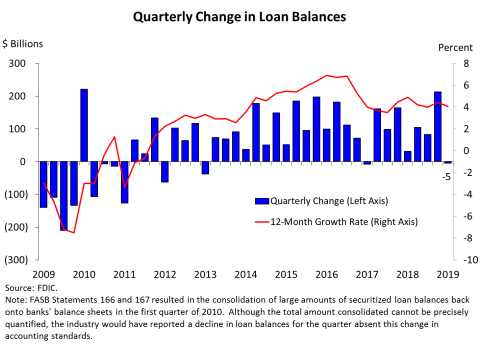
Chart 5 shows that loan balances fell by 5 billion dollars during the first quarter, as the increase among major loan categories was offset by the seasonal decline in credit card balances.
Over the past year, loan balances increased by 4.1 percent, which is a slight decline from the 4.4 percent annual growth rate reported last quarter.
Loan growth at community banks was strong, measuring 6.6 percent from a year ago. The annual growth rate was led by commercial real estate loans, residential mortgages, and commercial and industrial loans.
Chart 6:
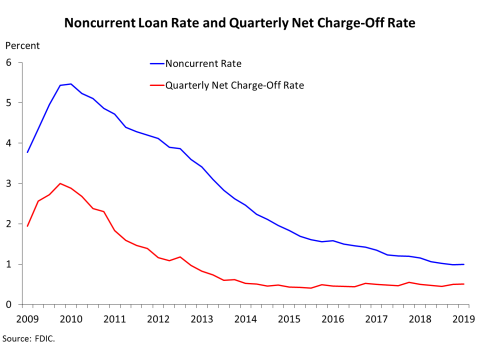
The next chart shows that overall asset quality indicators remain strong. The noncurrent rate remained unchanged from the previous quarter at 0.99 percent and the net charge-off rate remained stable from a year ago at 0.50 percent.
Among major loan categories, commercial and industrial loans saw the largest increase in noncurrent loan balances. While the noncurrent rate for commercial and industrial loans rose to 0.82 percent in the first quarter, it remains near last quarter's cyclical low.
Credit card balances registered the largest dollar increase in net charge-offs this quarter. The net charge-off rate for credit cards increased to 3.97 percent, but remains well below the previous high of 13.21 percent reported in first quarter 2010.
We continue to monitor challenges in the agriculture sector associated with low commodity prices and farm incomes. While the net charge-off rate for agriculture loans remains low, some farm banks are reporting asset quality deterioration. The noncurrent rate for agriculture loans at community banks increased in the first quarter to 1.28 percent, above the long-run average but below previous highs.
Chart 7:
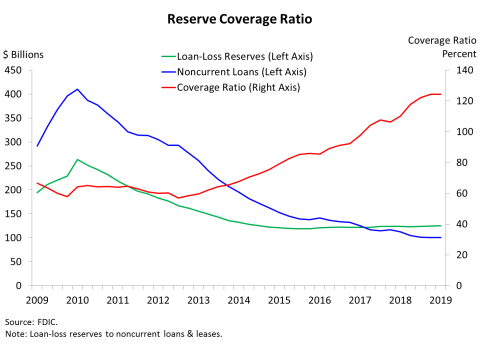
Chart 7 shows that the industry's reserve coverage ratio, which measures loan-loss reserves relative to total noncurrent loan balances, remained stable at 124 percent in the first quarter. The banking industry's capacity to absorb credit losses improved from a year ago, as noncurrent loan balances declined and loan-loss reserves remained relatively stable.
Chart 8:
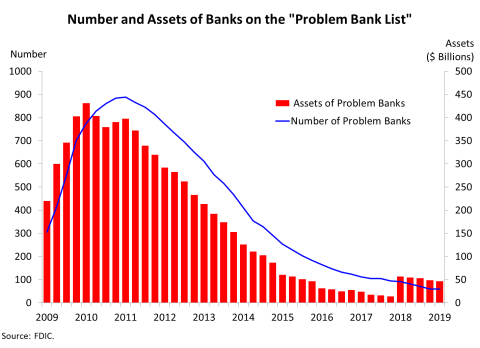
Chart 8 shows that the number of banks on the FDIC's "Problem Bank List" declined from 60 to 59 during the quarter. This is the lowest number of problem banks since first quarter 2007. One new bank opened, and no failures occurred in the first quarter.
Chart 9:
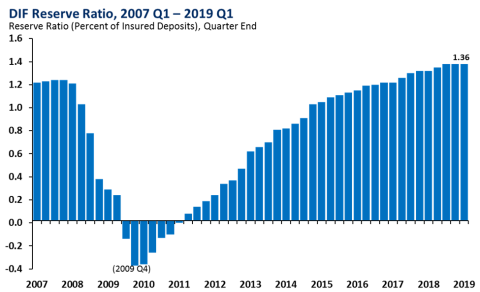
The Deposit Insurance Fund (DIF) balance was 104.9 billion dollars on March 31, up 2.3 billion dollars from the end of last quarter. The increase in the fund was largely driven by assessment income followed by interest income and unrealized gains on securities held by the DIF. Estimated insured deposits were 7.7 trillion dollars at the end of March, increasing 2.3 percent in the first quarter and 5 percent over the past four quarters.
Chart 9 shows that the reserve ratio—the amount in the Deposit Insurance Fund relative to insured deposits—held steady from last quarter as strong seasonal growth in insured deposits offset the growth in the DIF. The reserve ratio remained at 1.36 percent on March 31, 2019.
Small banks will receive credits for the portion of their assessments that contributed to growth in the reserve ratio from 1.15 percent to 1.35 percent. These credits amount to 765 million dollars in aggregate, and will be automatically applied to offset the assessments of small banks in periods that the reserve ratio is at least 1.38 percent.
In summary, the banking industry reported another positive quarter. Higher net interest income boosted quarterly net income. Loan balances grew year-over-year, net interest margins improved, and the number of "problem banks" continued to decline.
We will now answer any questions you have regarding first quarter performance of the banking industry.
Thank you.
